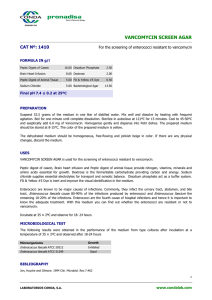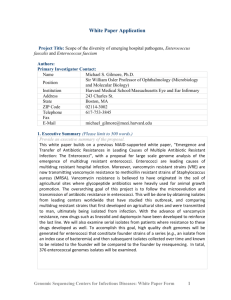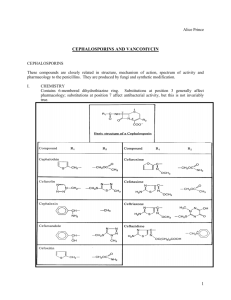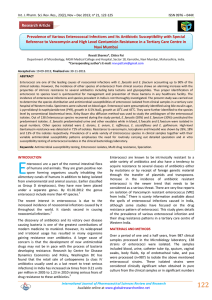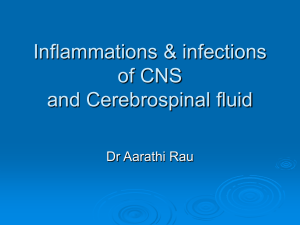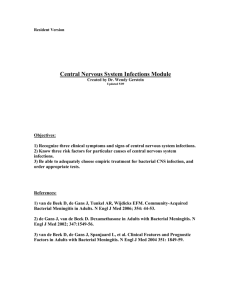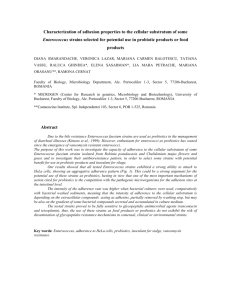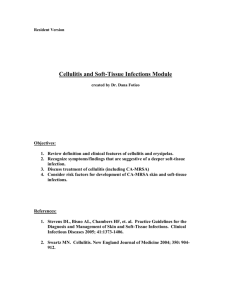Volume 24 - No 6: Enterococcus
advertisement
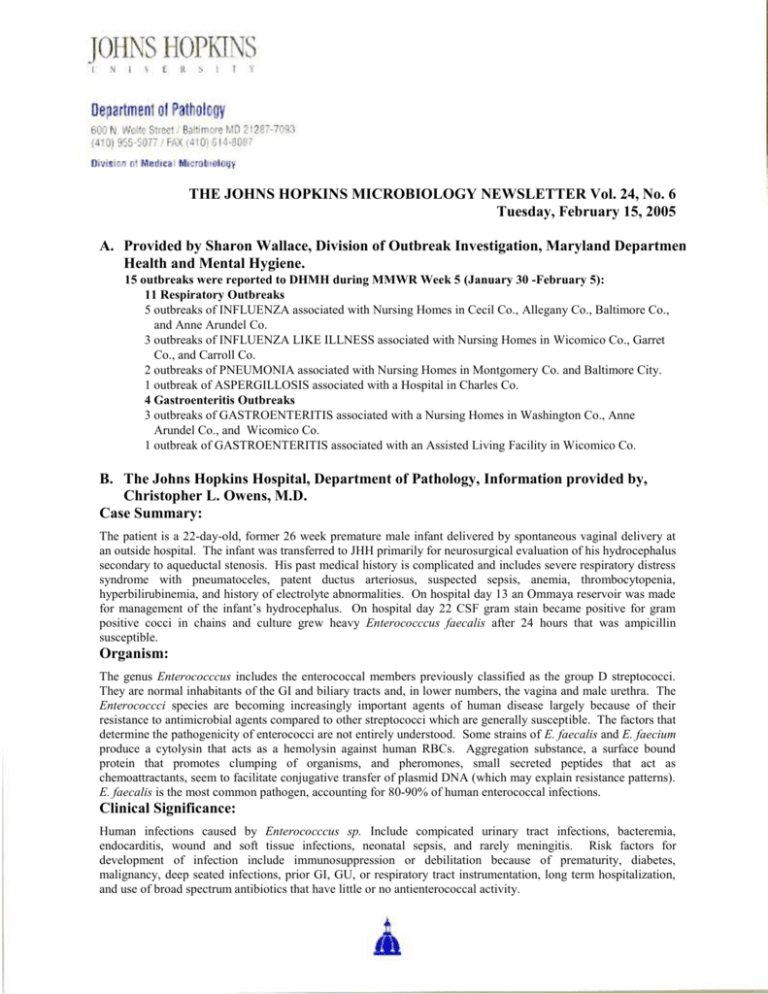
THE JOHNS HOPKINS MICROBIOLOGY NEWSLETTER Vol. 24, No. 6 Tuesday, February 15, 2005 A. Provided by Sharon Wallace, Division of Outbreak Investigation, Maryland Department of Health and Mental Hygiene. 15 outbreaks were reported to DHMH during MMWR Week 5 (January 30 -February 5): 11 Respiratory Outbreaks 5 outbreaks of INFLUENZA associated with Nursing Homes in Cecil Co., Allegany Co., Baltimore Co., and Anne Arundel Co. 3 outbreaks of INFLUENZA LIKE ILLNESS associated with Nursing Homes in Wicomico Co., Garret Co., and Carroll Co. 2 outbreaks of PNEUMONIA associated with Nursing Homes in Montgomery Co. and Baltimore City. 1 outbreak of ASPERGILLOSIS associated with a Hospital in Charles Co. 4 Gastroenteritis Outbreaks 3 outbreaks of GASTROENTERITIS associated with a Nursing Homes in Washington Co., Anne Arundel Co., and Wicomico Co. 1 outbreak of GASTROENTERITIS associated with an Assisted Living Facility in Wicomico Co. B. The Johns Hopkins Hospital, Department of Pathology, Information provided by, Christopher L. Owens, M.D. Case Summary: The patient is a 22-day-old, former 26 week premature male infant delivered by spontaneous vaginal delivery at an outside hospital. The infant was transferred to JHH primarily for neurosurgical evaluation of his hydrocephalus secondary to aqueductal stenosis. His past medical history is complicated and includes severe respiratory distress syndrome with pneumatoceles, patent ductus arteriosus, suspected sepsis, anemia, thrombocytopenia, hyperbilirubinemia, and history of electrolyte abnormalities. On hospital day 13 an Ommaya reservoir was made for management of the infant’s hydrocephalus. On hospital day 22 CSF gram stain became positive for gram positive cocci in chains and culture grew heavy Enterococccus faecalis after 24 hours that was ampicillin susceptible. Organism: The genus Enterococccus includes the enterococcal members previously classified as the group D streptococci. They are normal inhabitants of the GI and biliary tracts and, in lower numbers, the vagina and male urethra. The Enterococcci species are becoming increasingly important agents of human disease largely because of their resistance to antimicrobial agents compared to other streptococci which are generally susceptible. The factors that determine the pathogenicity of enterococci are not entirely understood. Some strains of E. faecalis and E. faecium produce a cytolysin that acts as a hemolysin against human RBCs. Aggregation substance, a surface bound protein that promotes clumping of organisms, and pheromones, small secreted peptides that act as chemoattractants, seem to facilitate conjugative transfer of plasmid DNA (which may explain resistance patterns). E. faecalis is the most common pathogen, accounting for 80-90% of human enterococcal infections. Clinical Significance: Human infections caused by Enterococccus sp. Include compicated urinary tract infections, bacteremia, endocarditis, wound and soft tissue infections, neonatal sepsis, and rarely meningitis. Risk factors for development of infection include immunosuppression or debilitation because of prematurity, diabetes, malignancy, deep seated infections, prior GI, GU, or respiratory tract instrumentation, long term hospitalization, and use of broad spectrum antibiotics that have little or no antienterococcal activity. Epidemiology: Enterococccus meningitis is relatively uncommon and accounts for approximately 0.3%-4.0% of all cases of bacterial meningitis. However, in patients with recent neurosurgery and neurohardware, enterococcal meningitis accounts for approximately 10% of cases of bacterial meningitis. In adults the clinical presentation is typical of bacterial meningitis with fever, change in mental status, meningeal signs, and headache being the predominant signs and symptoms. Enterococcci are becoming increasing recognized as potential devastating nosocomial infectious agents. Laboratory diagnosis: Identification of Enterococccus sp. is readily accomplished by biochemical tests. Enterococci grow well on routine laboratory media and produce visible colonies usually within 24 hours. The colonies on blood agar are typically medium sized gray/smooth colonies that are gamma-hemolytic. Biochemical properties of enterococci that can be utilized in identification are the ability to grow in the presence of bile and 6.5% NaCL. Pratically speaking, a colony and gram stain that is consistent with a group D streptococcus would have a rapid PYR test performed with subsequent identification based on results of commercially available kit systems as well as assessment of motility. Speciating enterococcci is important because different species have inherently different susceptibility patterns (for example most E. faecium strains are resistant to penicillins and ceophalosporins while most E. feacalis strains are susceptible to penicillins). Testing for resistance to antibiotics is another important laboratory function in the diagnosis of enterococcal infections. Enterococci isolated from sterile sites are tested for resistance to beta-lactams, aminoglycosides, and vancomycin (among others) at JHH. Ampicillin sensitivity/resistance is reported as well as predicted synergy with gentamycin. Low level resistance to gentamycin predicts that a combination of a cell wall agent and gentamycin will be bacteriocidal. High level resistance (i.e. MIC > 500 ug/ml) predicts a lack of bacteriocidal activity. High level resistance is due to the presence of a bifunctional aminoglycoside inactivating enzyme. Streptomycin remains an alternative if suspectible (MIC < 2000 ug/ml) in gentamycin resistant strains. In ampicillin resistant strains vancomycin susceptibility would be reported. Vancomycin resistance would always be reported (even in ampicillin sensitive strains). Vancomycin resistant-enterococci (VRE) have been characterized as having the Van A, Van B, or Van C phenotypes. E. faecalis and E. faecium isolates that have the Van A phenotype display inducible, transposon mediated, high level resistance to vancomycin (MIC>64ug/ml) and teicoplanin. Van B isolates have inducible varying levels of vancomycin resistance but remain susceptible to teicoplanin. Van C isolates have intrinsic low level resistance to vancomycin and are also susceptible to teicoplanin. This genotype is intrinsic in E. casselliflavus and E. gallinarum and is not transferred to other organisms. Enterococci with the Van A phenotype are the most worrisome because of the ability to transfer the to other gram positive organisms, such as S. aureus resistance determinants. Treatment: Serious infections with enterococci are treated with a combination of a penicillin or ampicillin with an aminoglycoside. The emergence of strains with a high level of resistance to aminoglycosides is seriously affecting the therapeutic approach of enterococci infections. The high level resistance is transposon mediated and can be transferred to other organisms. In such cases aminoglycosides are not synergistic and provide no addition therapeutic effect. Other newer agents with activity against Enterococci include quinupristin-dalfopristin, linezolid, and daptomycin. References: www.uptodate.com Koneman, EW: Color Atlas and Textbook of Diagnostic Microbiology, 5 th ed. New York, Lippincott Williams & Williams, 1997. Forbes, BA: Bailey & Scott’s Diagnostic Microbiology, 11 th ed. St. Louis, Mosby, 2002. Pintado V, et al: Enterococcal Meningitis: A Clinical Study of 39 Cases and Review of the Literature. . 2003 Sep;82(5):346-64.
